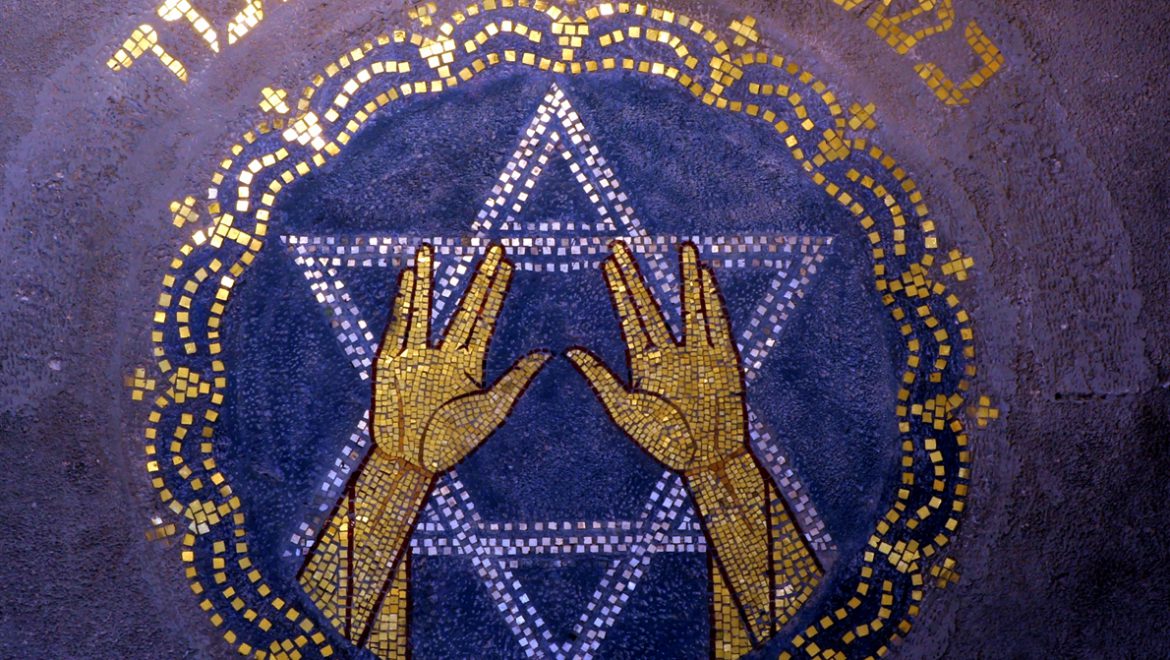
This informative article by the late Rabbi Louis Jacobs explains the origins, meaning, and practice of the Priestly Blessing in the synagogue service, which also is part of the blessing over the children on Friday nights. The author describes when, where and how the ritual is practiced, as well as introducing the concept of the Kohanim (Priests) as Divine conduits. This article, reprinted on MyJewishLearning.com, is an excerpt from Rabbi Jacob's book "The Jewish Religion: A Companion," a comprehensive work on Jewish belief and practice, wisdom and culture, history and tradition. Rabbi Louis Jacobs was the first leader of Masorti (Conservative) Judaism in the United Kingdom.
The Priestly Blessing
The Priestly Blessing is the blessing recited by the priests (kohanim) in ancient times in the Temple and nowadays in the synagogue. The biblical source is Numbers 6:22-7:
The Lord spoke to Moses: Speak to Aaron and his sons: Thus shall you bless the people of Israel. Say to them: The Lord bless you and protect you! The Lord deal kindly and graciously with you! The Lord bestow His favor upon you and grant you peace! Thus they shall link My name with the people of Israel, and I will bless them.
The blessing is in three parts and is called “the threefold blessing.” In the Hebrew the first section consists of three words, the second of five, and the third of seven.
In the Temple the priests recited the blessing twice daily, in the morning and afternoon, while they stood on a special platform, known as the dukhan (‘platform’). In the synagogue the blessing is recited by the priests while standing in front of the Ark. To this day, the recital of the priestly blessing is called in Yiddish dukhenen, literally, ‘platforming,’ after the Temple procedures.
When, Where, How
In Israel the blessing is recited on the Sabbath as well and in Jerusalem it is recited daily. A reference is made by the Reader to the priestly blessing during his repetition of the Amidah in the daily morning service.
The procedure in the synagogue is as follows. The Kohanim remove their shoes and have their hands ritually washed by Levites. If there is no Levite in the congregation the washing of the hands of the Kohanim is done by a first-born and, failing that, by the Kohanim themselves.
The Kohanim then stand before the Ark and the Reader calls out the word: ‘Kohanirn’ as a signal for the priests to begin. The Kohanim then cover their heads with the prayer shawl, the tallit, and recite an introductory benediction: ‘Blessed art Thou O Lord our God, King of the universe, who hast hallowed us with the sanctity of Aaron and commanded us to bless His people Israel in love.’
The Kohanim then raise their hands and arrange the fingers so as to form ‘windows.’ The idea behind this is that the blessing proceeds from God as if He is sending it through the apertures of the hands–a symbolic way of expressing the idea that God’s blessing is present even when He hides Himself, so to speak.
The Reader then recites the blessing word by word, the Kohanim chanting each word after the Reader.
Reform and many Conservative congregations have dispensed with the priestly blessing.
The blessing is also recited by parents in the home before the Sabbath meal but this is simply a pious custom. The priestly blessing proper in the synagogue can only be carried out by Kohanim.
Kohanim as Conduits
The medieval thinkers discuss the obvious question of why God needs to bless the people through the Kohanim. Replies differ. Some believe that the Kohanim, the ancient teachers of the Torah, represent the blessings that stem from observance of God’s law. Others see the Kohanim as the instruments by means of which God’s blessings are transmitted. Human cooperation with the divine is required if blessings are to follow.
In all interpretations a determined effort is made to play down any magical elements. It is God alone who blesses His people. The Kohanim are, at the most, the vehicles He uses to transmit His blessings.

